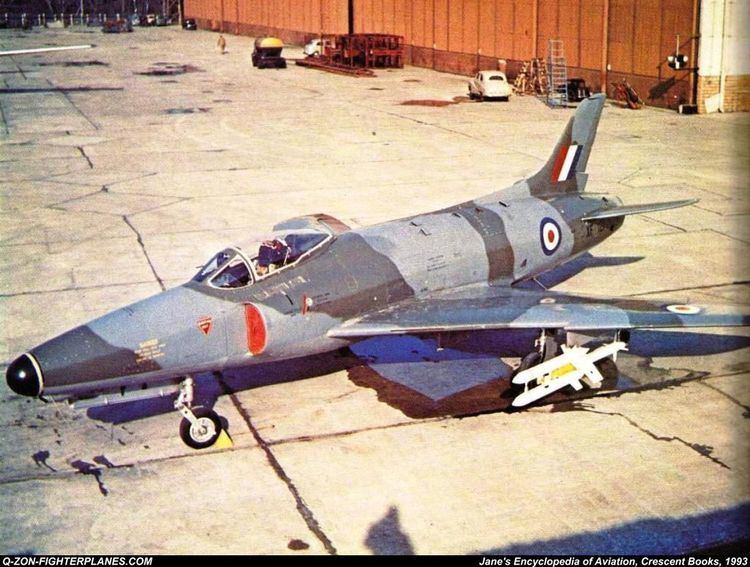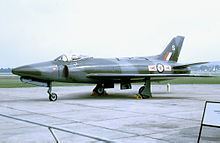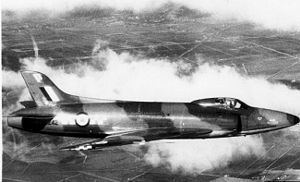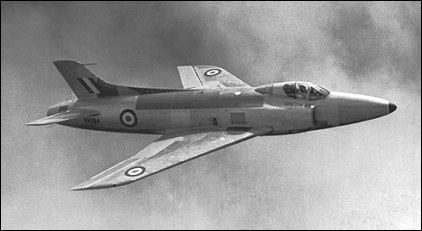Top speed 1,147 km/h Length 13 m | Wingspan 9.85 m First flight December 29, 1948 Designer Joseph Smith | |
 | ||
Engine types Turbojet, Rolls-Royce Avon | ||
Supermarine swift
The Supermarine Swift was a British single-seat jet-propelled fighter aircraft that was operated by the Royal Air Force (RAF). It was developed and manufactured by Supermarine during the 1940s and 1950s. The Swift featured many of the new jet age innovations, such as a swept wing. On 26 September 1953, an Swift F.4 piloted by Commander Mike Lithgow broke the world absolute speed record, reaching a speed of 737.7 mph (1,187 km/h); thus, the Swift held the distinction of being the world's fastest aircraft.
Contents
- Supermarine swift
- Warplane disasters episode 13 the supermarine swift
- Background
- Into production
- Proposed derivative
- Operational history
- Variants
- Operators
- Survivors
- Specifications Supermarine Swift FR Mk 5
- References
After a protracted development period, the Swift entered service as an interceptor aircraft with the RAF in 1954. However, due to a spate of accidents incurred by the type, the Swift was grounded for a time, and experienced a relatively brief service life. These issues with the Swift led to a public scandal surrounding the aircraft, harming the reputations of the British government, the RAF, and the aircraft industry.

Ultimately, the less problematic Hawker Hunter assumed much of the intended role for the type and only half as many Swifts ended up being manufactured as had once been intended. A later-produced photo reconnaissance variant of the Swift had resolved some of the teething problems that the type had suffered from, but this proved to be too late for it to regain favour. An advanced derivative of the Swift that was to be capable of transonic speeds, the Supermarine 545, was also under development during the early 1950s; however, in 1955, it was cancelled principally due to the poor performance of the Swift.
Warplane disasters episode 13 the supermarine swift
Background

During 1945, the Second World War came to a close and a new postwar Labour government, headed by Clement Attlee, came to power in Britain. The incoming Attlee government's initial stance on defence was that no major conflict would occur for at least a decade, and thus there would be no need to develop or to procure any new aircraft until 1957. In accordance with this policy, aside from a small number of exceptions such as what would become the Hawker Sea Hawk for the Royal Navy, the majority of Specifications issued by the Air Ministry for fighter-sized aircraft during the late 1940s were restricted to research purposes. Aviation author Derek Wood refers to this policy as being: "a fatal error of judgement which was to cost Britain a complete generation of fighters and heavy bomber aircraft".

In part, the Swift has its origins amongst these experimental fighter prototypes that were developed. Specifically, a number of Supermarine-built prototypes had been ordered under Specification E.41/46, which had sought the production of an experimental fighter aircraft furnished with a swept wing. The first of these prototypes was designated as the Type 510, which was heavily based on the straight-wing Supermarine Attacker, an early jet aircraft which was procured by the Fleet Air Arm (FAA) of the Royal Navy; the principal difference from the Attacker was that it had been modified with the addition of a swept wing configuration. During 1948, the Type 510 had conducted its maiden flight, a year after the first navalised prototype Attacker had flown. This flight made it the first British aircraft to fly with both swept wings and a swept tailplane. The Type 510 also held the distinction of being the first swept-wing aircraft to take off from and land upon an aircraft carrier during trials held for the Fleet Air Arm.

During the late 1940s, in the face of the emerging Cold War scenario, the RAF came to recognise that it would urgently require the development and procurement of fighters equipped with features such as swept wings; this need was felt to be so pressing that they were willing to accept interim fighter aircraft while more capable fighters would continue to be pursued. In 1950, the outbreak of the Korean War and Britain's heavy involvement in this conflict led to a flurry of orders being issued; in particular, the RAF felt that a pair of proposed fighter aircraft from Hawker Aircraft and Supermarine were of high importance and thus placed orders for these proposed fighters 'off the drawing board' in 1950. The proposed Supermarine design was designated as the Type 541, which was essentially an advanced development of the earlier Type 510 experimental aircraft.

The initial order that had been placed in 1950 for 100 aircraft was intended to serve as an insurance policy in the event of the Hawker effort failing to produce a viable aircraft; these two aircraft would later become known as the Supermarine Swift and the Hawker Hunter respectively. In early 1946, the Type 541 order was increased to 150 aircraft, while the Air Ministry had hopes that it would be able to enter service in advance of the rival Hunter. However, the development of both the Swift and the Hunter would be protracted and also encountered several considerable technical challenges; according to Wood, this had been in part due to a failure to procure interim aircraft equipped with swept wings or to proceed with development of the Miles M.52. Wood describes the Swift as being "literally an attempt to squeeze a quart into a pint pot, with 30mm Aden guns, afterburning, power controls, adequate fuel and a respectable high subsonic performance".
The Type 541 replaced its predecessors' Rolls-Royce Nene centrifugal flow turbojet engine with the axial-flow Rolls-Royce AJ.65 turbojet engine, which became the famed Avon series. The fuselage, which had been given a cross section suitable for the Nene engine, was not redesigned for the narrower AJ.65 and Avon engines, and retained a somewhat portly appearance. It was also equipped with a tricycle undercarriage arrangement. A pair of Type 541 prototypes were produced; the first of these prototypes made its maiden flight in 1951 and the second during the following year.
Into production
The Swift had been declared to be a production "super-priority" item under a policy which had been created by Sir Winston Churchill (who had regained the position of Britain's Prime Minister in 1951) as a means of increasing production for projects considered to be of vital military importance. According to Wood, volume manufacturing commenced in advance of the implementation of modifications based on the results of flight experiences with the prototypes; "too much had been asked for in too little time and production aircraft were rolling off the production line before a major redesign could be accomplished".
The first production variant was a fighter designated the Swift F Mk 1, of which 18 were eventually built. It was powered by a single 7,500 lbf (33.4 kN)-thrust Avon 109 engine and carried an armament of two 30 mm ADEN cannons. On 25 August 1952, the first flight of a production standard Swift F 1 took place. Peter Thorne, who had been appointed as the senior RAF test pilot for the incoming Swift in 1954, came to doubt the aircraft's suitability; observations by Thorne and several other pilots noted the Swift to possess unusual handling qualities alongside a troublesome engine.
The second variant was the Swift F Mk 2, of which 16 were built. This was practically the same as the earlier F 1, except for being fitted with two extra ADENs and the leading edge of the wing being altered from straight to a compound sweep configuration. However, the addition of these cannon caused problems as the structural modifications required to house the increased ammunition load led to dangerous handling problems with the aircraft and it was clear that more thrust was required from its engine. Numerous further modifications were then required to resolve the issues.
The third Swift variant was the F Mk 3, with 25 being built and powered by an Avon 114 engine with reheat. It was never taken into operational service with the Royal Air Force and was used as an instructional airframe. The next variant was the F Mk.4, which included a variable incidence tailplane intended to correct the handling problems that the Swift suffered from. It did indeed fix the problem; however, it was found that reheat could not be ignited at high altitude which added to the Swift's list of problems.
The next in the line, the FR Mk 5, had a longer nose to accommodate a number of cameras to suit the reconnaissance role and had other modifications to its structure. The FR 5 also reverted to the F 1's twin ADEN cannon armament. It first flew in 1955 and entered service the following year. It performed its reconnaissance mainly at low level, making the reheat problem at high altitude irrelevant.
Two further variants were designed; the PR Mk 6 was an unarmed photo reconnaissance variant. However, it was a short-lived program due to ever-present reheat problems. The last variant was the F Mk 7; this model was the first Swift variant to be fitted with guided missiles, having been armed with the Fairey Fireflash air-to-air missile and was powered by a new model of the Avon engine. Only fourteen F 7 aircraft were built and none of these ever entered service with the RAF, being relegated - along with its prototype missiles - to conducting guided-missile trials duties only.
Proposed derivative
In 1953, as a response to growing RAF interest in developing transonic aircraft to serve as a stopgap while the next generation of supersonic fighters were being developed, both Supermarine and Hawker proposed derivatives of their respective Swift and Hunter aircraft. By this point, the shortcomings of the Swift were not yet apparent, which perhaps had allowed Supermarine to gain the RAF's favour for their proposal, designated as the Type 545, over the rival Hawker P.1083. The Type 545 had been drawn up to conform with the requirements given by Specification F.105D; it was projected to have been capable of attaining Mach 1.3 and powered by a model of Avon engine, promising superior performance to that of the P.1083. Externally, the Type 545 bore a crude resemblance to the Swift, and would have served as a spiritual successor to it, but was radically redesigned with an area-ruled fuselage and wing changes. In 1955, work on the project was cancelled, in part due to the considerable difficulties experienced with the Swift.
Operational history
In February 1954, the Swift F 1 entered service with the RAF, No. 56 Squadron became the first RAF squadron to operate the type; upon its introduction, the Swift became the RAF's first swept-wing aircraft. The Swift F 2 entered service that same month; Wood refers to the type's introduction as having been "panicked", and that this adoption soon proved to be an "abysmal failure". Tragedy struck very early in the career of the Swift: there were a number of accidents that involved the F 1 and F 2, one of these being fatal. In August 1954, it was decided that the Swift F 1 would be grounded; the Swift F 2, which had effectively replaced the F 1 in that same month, was also soon grounded alongside it due to similar reasons.
The improved Swift F 3 and F 4 fighters were noted to have improved performance over their predecessors; the F 4 would be the last variant that the RAF would accept in the interceptor role. All fighter variants of the Swift were withdrawn from service by the RAF, after a short time in service, to be replaced by the more capable Hawker Hunter. While subject to its own problems, the Hunter had quickly proved to be a successful fighter aircraft. By autumn 1954, the issues with the Swift had become public knowledge and reports of the pending cancellation of the Swift were being printed by the national press; Under-Secretary of State for Air Sir George Ward stated of the aircraft in Parliament that: "Aerodynamic difficulties have been encountered, and it is not possible to say with certainty if they can be overcome in version under development".
In early February 1955, the Swift was rumoured to have failed its final evaluation by the RAF Central Fighter Establishment, and that the type would likely be restricted in RAF service to aerial reconnaissance or to ground attack roles as a result. On 2 March 1955, Minister of Supply Selwyn Lloyd acknowledged that development of the Swift had cost £20 million prior to the scrapping of the fighter variants. According to Wood, the Swift had become a national scandal by early 1955, which not only tarnished the aircraft but also the RAF and the British aircraft industry, the public and ministers alike generally adopting a more adverse nature to aviation and other aircraft projects.
The FR.5 was the last Swift variant to enter service with the RAF and was eventually replaced by the Hunter FR.10, leaving RAF service entirely in 1961. The Swift FR 5 was deemed to be suitable for its role and was based with two squadrons that were assigned to RAF Germany. The Swift never saw combat action with the RAF. It did break a number of speed records in its time; in Libya, on 26 September 1953, an F.4 (WK198) piloted by Commander Mike Lithgow broke the world absolute speed record, reaching a speed of 737.7 mph (1,187 km/h), though it was broken in turn just eight days later by the Douglas Skyray, a United States Navy (USN) fighter. The Swift has the distinction of being the last British production aircraft to hold this record (the Fairey Delta 2 was experimental). Under two hundred Swifts were built from an order of 497. A number of Swift airframes went to Australia for Operation Buffalo in 1956, being placed at various distances from a detonating atomic bomb.
By its last variant many of the problems that had plagued earlier Swifts were resolved but the programme was not continued. The Hunter, performing satisfactorily in the same roles, removed any requirement to persist with the Swift.
Variants
Operators
Survivors
Specifications (Supermarine Swift FR Mk 5)
Data from Supermarine Aircraft since 1914 (2nd ed.)
General characteristics
Performance
Armament
